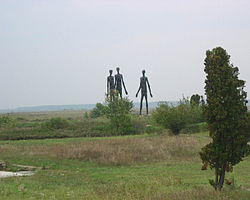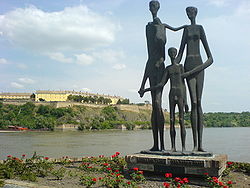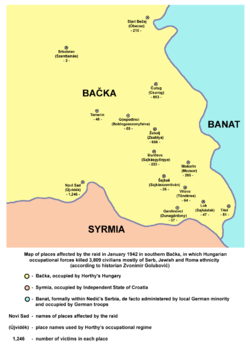- 1942 raid in southern Bačka
-
Monument to the victims in Novi Sad

 Monument of the 1942 raid victims near Žabalj
Monument of the 1942 raid victims near Žabalj
The 1942 raid in southern Bačka was a genocidal attack[1] against civilians in Hungarian occupied Bačka in January 1942, after the Axis invasion and partition of Yugoslavia. The raid was performed in several places in southern Bačka, including Novi Sad (an event commonly known as the Novi Sad massacre), villages and towns in Šajkaška, as well as the towns of Temerin, Srbobran and Bečej. An estimated 3,000 to 4,000 civilian hostages, mostly of Serb, Jewish and Roma ethnicity, were rounded up and killed by the Hungarian Axis troops. The occupiers characterized the raid as a reprisal for resistance activities, [2] [3] although it appears that the real aim was liquidation of "unwanted elements".[4] The massacre is considered one of the most notable war crimes during the Axis occupation of Serbia.
Using minor local partisan activity as an excuse, Hungarian forces assembled 240 patrols in southern Bačka, near Novi Sad, purportedly to conduct anti-partisan raids. The patrols rounded up and executed civilians allegedly suspected of aiding local resistance fighters. However, until the end of 1941, the resistance movement in Bačka was largely defeated. Thus, the real aim of the raid appears to be a campaign of ethnic cleansing against innocent ethnic Serb and Jewish civilians (including women, children and the elderly), as well as robbery of their property. Already in 1941, about 2,500 Serbs had been killed and about 65,000 expelled from Bačka by the occupying Hungarian authorities.[5][6] Some of the Novi Sad victims were taken to the bank of the Danube, where they were shot and their bodies thrown onto the frozen river. The Hungarian forces then broke the ice, shooting at the drowning survivors.[7]
Contents
Casualties
According to historian Zvonimir Golubović, the total number of civilians killed in the raid is estimated at 3,809.[8] According to other source[s] it is estimated at 4,211. The victims were killed in Novi Sad and in several nearby settlements, including Bečej, Vilovo, Gardinovci, Gospođinci, Đurđevo, Žabalj, Lok, Mošorin, Srbobran, Temerin, Titel, Čurug and Šajkaš.[3] The victims included 2,842 Serbs, 1,250 Jews, 64 Roma, 31 Rusyns, 13 Russians and 11 ethnic Hungarians.[9] Civilians were rounded up at random and taken from their homes and businesses during their workday and while they were engaged in regular activities, even weddings.
Table that show victims of 1942 raid by gender, age and ethnicity (according to historian Zvonimir Golubović):[8]
Place Total Men Women Children Old people Serbs Jews Roma Rusyns Hungarians Russians Bečej 215 111 72 13 19 102 110 - - - - Vilovo 64 44 6 8 6 64 - - - - - Gardinovci 37 32 3 - 2 37 - - - - - Gospođinci 85 47 19 15 4 73 10 - 2 - - Đurđevo 223 107 60 41 15 173 22 - 27 - - Žabalj 666 355 141 101 69 614 28 23 - 1 - Lok 47 46 - - 1 46 - - - 1 - Mošorin 205 94 41 44 26 170 - 34 - 1 - Novi Sad 1,246 489 415 165 177 375 809 - 2 18 15 Srbobran 3 3 - - - 2 2 - - - - Temerin 48 14 15 7 12 6 42 - - - - Titel 51 45 - 1 5 49 1 - - - - Čurug 893 554 153 82 104 842 44 7 - - - Šajkaš 26 24 2 - - 25 1 - - - - All places 3,809 1,965 927 477 440 2,578 1,068 64 31 21 15 Causes and initiators
.
The raid was performed because, allegedly, about 40 Yugoslav partisans (Šajkaška partisan detachment) were found hiding at the farm of Gavra Pustajić near the town of Žabalj by a Hungarian patrol on January 4, 1942. Due to the weak condition of the resistance movement in Bačka at the end of 1941, this was the only partisan detachment in Bačka and it had not performed any recent actions. During the clash between the partisans and the Hungarian patrol, 10 members of the patrol and 7 partisans were killed. The remainder of the partisan detachment were murdered over the next several days. Therefore, from the point of view of military and state security, this particular partisan resistance was finished on the same day it started and, as such, there was no legitimate reason for the raid. According to historian Zvonimir Golubović, it was planned much earlier and the attack on the partisans in Šajkaška was just an excuse for the implementation of a planned genocide.[10] The raid in Šajkaška began on January 4 (the same day as the Hungarian patrol clashed with the partisans near Žabalj).
Raids were carried out in Šajkaška from January 4 to January 19, 1942; in Novi Sad from January 21 to January 23; and in Bečej from January 25 to January 29. The raids were ordered by lieutenant-general Ferenc Feketehalmy-Czeidner, major-general József Grassy, colonel László Deák and gendarmerie captain Márton Zöldy, but, according to historian Zvonimir Golubović, they were planned by the highest military and civil officials of Hungary, including Chief of Staff Ferenc Szombathelyi, Minister of Internal Affairs Ferenc Keresztes Fiser, Minister of People's Defense Károly Barta, President of the Hungarian government László Bárdosi, and Regent Miklós Horthy himself.[11]
Responsibility
Some Serbian historians who researched the raid (Zvonimir Golubović, Aleksandar Veljić) claim that Horthy himself was aware of the raids and approved their being carried out.[12][13] However, Horthy was a witness at the Nuremberg Trials after World War II, and all accusations were dropped against him. The raids were an embarrassment for Hungary even in the eyes of its Axis allies, and Horthy was forced to investigate the crimes during the war. Based on this, Horthy was not deemed responsible and despite the strong demand from Yugoslavia, both the Americans and the Soviets favored dropping the charge.[14][15][16][17] However, when Horthy ordered the investigation, the officers who had ordered the raids fled to Nazi Germany and returned only after the German forces occupied Hungary in 1944.
Aftermath
In 1943, the Hungarian leaders attempted to revive relations with the western Allies, and as part of such aims, Hungary organized a trial of several officers who were among those responsible for the raids.[16][17] However, the officers were allowed to escape to Germany before their sentencing.[18] After the war, some of the individuals responsible for the raids were tried again by the new communist government of Hungary (which sentenced them to death or to life in prison) and again in Yugoslavia, where they were sentenced to death again, and executed. Miklos Horthy who was, according to Yugoslav/Serbian historians, also among those responsible for the raids, was never convicted.
In 2006, Dr. Efraim Zuroff of the Simon Wiesenthal Center charged Dr. Sándor Képíró with participating in the massacres on the evidence of his conviction in the trials of 1944 and 1946. Képíró, however, stated that as a police officer, his participation was limited merely to arresting civilians, and he did not take part in the executions or any other illegal activity.[19] War crimes charges were subsequently brought against Képíró in a federal court in Budapest, for murders of civilians committed under his command during the January 1942 raids. His trial on those charges commenced in May 2011. [20] Képíró has twice previously been found guilty: once by the wartime Hungarian courts, and again after the war, in 1946. By then he had, allegedly, fled to Argentina, but returned to Budapest in 1996.[21] In July, 2011, the Hungarian court ruled that Képíró was not guilty of participation in the raids.[22] The decision of the court was welcomed and applauded by members of the extreme right who were present in the courtroom.[22]
See also
- Occupation of Vojvodina, 1941-1944
- Hungarian occupation of Baranja and Bačka, 1941–1944
- Greater Hungary (political concept)
- Communist purges in Serbia in 1944–1945
References
- ^ Lajčo Klajn, The past in present times: the Yugoslav saga, University Press of America, 2007.
- ^ Billy Briggs (12 April 2009). "Revealed: the Scots pensioner and the Nazi war crimes investigation". Scotland on Sunday (Edinburgh). http://scotlandonsunday.scotsman.com/scotland/Revealed-the-Scots-pensioner-and.5164273.jp. Retrieved 18 May 2011.
- ^ a b Zvonimir Golubović, Racija u Južnoj Bačkoj, 1942. godine, Novi Sad, 1991. (pages 146, 147)
- ^ Jovan Pejin, Velikomađarski kapric, Zrenjanin, 2007, page 96.
- ^ Zvonimir Golubović, Racija u Južnoj Bačkoj 1942. godine, Novi Sad, 1992, page 44.
- ^ Zvonimir Golubović, Racija 1942, Enciklopedija Novog Sada, knjiga 23, Novi Sad, 2004, page 219.
- ^ Carl Savich Column on Serbianna.com | Front Page
- ^ a b Zvonimir Golubović, Racija u Južnoj Bačkoj 1942. godine, Novi Sad, 1992, page 147.
- ^ Yahil, Leni (1990). The Holocaust. Oxford Oxfordshire: Oxford University Press. ISBN 019504522X., p.503
- ^ Zvonimir Golubović, Racija u Južnoj Bačkoj 1942. godine, Novi Sad, 1992, page 43.
- ^ Zvonimir Golubović, Racija 1942, Enciklopedija Novog Sada, knjiga 23, Novi Sad, 2004, page 221
- ^ Zvonimir Golubović, Racija u Južnoj Bačkoj, 1942. godine, Novi Sad, 1992. (page 194)
- ^ Aleksandar Veljić, Mikloš Horti - Nekažnjeni zločinac, Beograd, 2009.
- ^ Thomas L. Sakmyster, Miha Tavcar Hungary, the Great Powers, and the Danubian Crisis, 1936-1939 (ISBN 0820304697)
- ^ Thomas L. Sakmyster: Miklos Horthy (Univ. of Georgia Press, 1980, ISBN 9783902494146)
- ^ a b Ilona Edelsheim-Gyulai: Becsület és kötelesség, part I p.236 (Európa press, Budapest, 2001.) ISBN 963-07-6544-6
- ^ a b Miklós Horthy: Memoirs p. 235-236 ISBN 0966573439 (PDF)
- ^ Zvonimir Golubović, Racija u Južnoj Bačkoj, 1942. godine, Novi Sad, 1991. (page 187)
- ^ "Nazi hunters identify convicted war criminal", Nicholas Wood, International Herald Tribune, September 28, 2006
- ^ "97-year-old Hungarian Sandor Kepiro on trial for Nazi war crimes" [1]
- ^ "Kepiro war crimes trial continues in Budapest" [2]
- ^ a b http://www.rts.rs/page/stories/sr/story/11/Region/926336/Kepiro+oslobođen.html
Literature
- Zvonimir Golubović, Racija u Južnoj Bačkoj 1942. godine, Novi Sad, 1992.
- Zvonimir Golubović, Racija 1942, Enciklopedija Novog Sada, knjiga 23, Novi Sad, 2004.
- Aleksandar Veljić, Racija - Zaboravljen genocid, Beograd, 2007.
- Aleksandar Veljić, Istina o Novosadskoj raciji, Sremska Kamenica, 2010.
- Aleksandar Veljić, Mikloš Horti - Nekažnjeni zločinac, Beograd, 2009.
- Jovan Pejin, Velikomađarski kapric, Zrenjanin, 2007.
- Dimitrije Boarov, Politička istorija Vojvodine, Novi Sad, 2001.
- Đorđe M. Srbulović, Kratka istorija Novog Sada, Novi Sad, 2011.
- Peter Rokai - Zoltan Đere - Tibor Pal - Aleksandar Kasaš, Istorija Mađara, Beograd, 2002.
- Enike A. Šajti, Mađari u Vojvodini 1918-1947, Novi Sad, 2010.
External links
- Godišnjica Novosadske racije - Commemoration dedicated to the raid victims (in Serbian)
- Partial list of victims of the raid in Novi Sad, in the area that was under command of Sandor Kepiro (in Serbian)
Categories:- The Holocaust in Serbia
- Yugoslav Serbia
- History of Vojvodina
- Jewish Serbian history
- World War II crimes
- Yugoslavia in World War II
- History of Bačka
- 1942 in Yugoslavia
Wikimedia Foundation. 2010.







